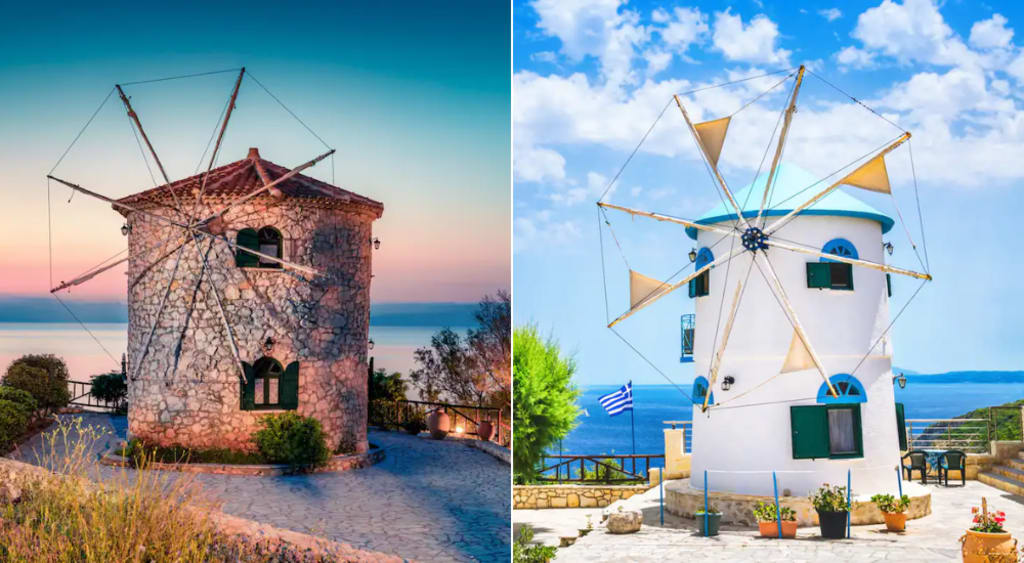Windmills of Mykonos: The History of a Landmark
Greek Windmill: One of the earliest examples of harnessing wind power, used for grinding grain and pumping water.

The windmills of Mykonos are more than just a picturesque element of the Greek island's landscape; they are a historical landmark that tells the story of the island's economic and cultural development. These iconic structures, with their whitewashed cylindrical shapes and wooden sails, have been a defining feature of Mykonos for centuries, symbolizing the island's rich heritage and its adaptation to the natural environment.
The history of the windmills dates back to the 16th century, during the time of Venetian rule. Positioned strategically to harness the strong northern winds, known as the Meltemi, the windmills played a crucial role in the island's economy by grinding grain into flour. This was essential for both local consumption and trade, as Mykonos became a key player in the Aegean's grain distribution network. The windmills were so effective and vital that they continued to be used well into the 20th century, despite the advent of modern milling technology.
The design of the windmills reflects a deep understanding of both the local climate and the materials available. Typically, each windmill consists of a round, whitewashed stone tower with a conical roof made of wood or straw. The height of these structures allowed them to catch the most wind, and their thick walls provided stability against the strong gusts. The sails, usually made of wood and cloth, were mounted on a horizontal wheel connected to a vertical shaft that powered the grinding mechanism inside. This efficient design maximized the energy captured from the wind, allowing for continuous operation even during harsh weather conditions.
The operation of the windmills was both a technical and communal effort. Skilled millers, often inheriting the craft through generations, managed the milling process. They had to understand the wind patterns and maintain the machinery to ensure optimal performance. The windmills were typically owned by wealthy families or the community, and the flour produced was a vital resource for the islanders, supporting local bakers and providing a staple food supply. The surplus flour was often exported, contributing to the island's wealth and prosperity.
Beyond their practical use, the windmills of Mykonos have become a symbol of the island's resilience and cultural identity. They represent a period when the island was a bustling hub of trade and maritime activity. The sight of these windmills against the backdrop of the azure Aegean Sea has inspired countless artists, writers, and travelers, cementing their status as a cherished landmark. Today, they are one of the most photographed and visited sites on Mykonos, attracting tourists from around the world who come to admire their beauty and learn about their history.
The preservation and restoration of the windmills have become a priority in recent years, recognizing their historical and cultural significance. Local and national efforts have been made to maintain these structures, ensuring that they remain a part of Mykonos' heritage. Some windmills have been converted into museums or exhibition spaces, where visitors can learn about the traditional milling process and the island's history. Others have been adapted for modern use, serving as private homes or unique accommodations that offer a glimpse into the past.
The windmills of Mykonos also play a role in contemporary cultural events. They are often featured in local festivals and celebrations, highlighting their enduring importance to the island's community. These events help to educate younger generations about their heritage and the ingenuity of their ancestors. The windmills stand as a reminder of how the islanders harnessed the power of nature to sustain their community and thrive in a challenging environment.
As researchers and historians continue to study the windmills of Mykonos, more details are expected to emerge about their construction, usage, and cultural significance. This ongoing research will likely uncover further aspects of the island's economic history, architectural innovation, and social organization. By delving deeper into these findings, historians hope to gain a more comprehensive understanding of how the people of Mykonos adapted to their environment and created sustainable solutions that have endured for centuries.
About the Creator
Marveline Merab
“History never repeats itself. Man always does.”
― Voltaire
Enjoyed the story? Support the Creator.
Subscribe for free to receive all their stories in your feed. You could also pledge your support or give them a one-off tip, letting them know you appreciate their work.






Comments
There are no comments for this story
Be the first to respond and start the conversation.